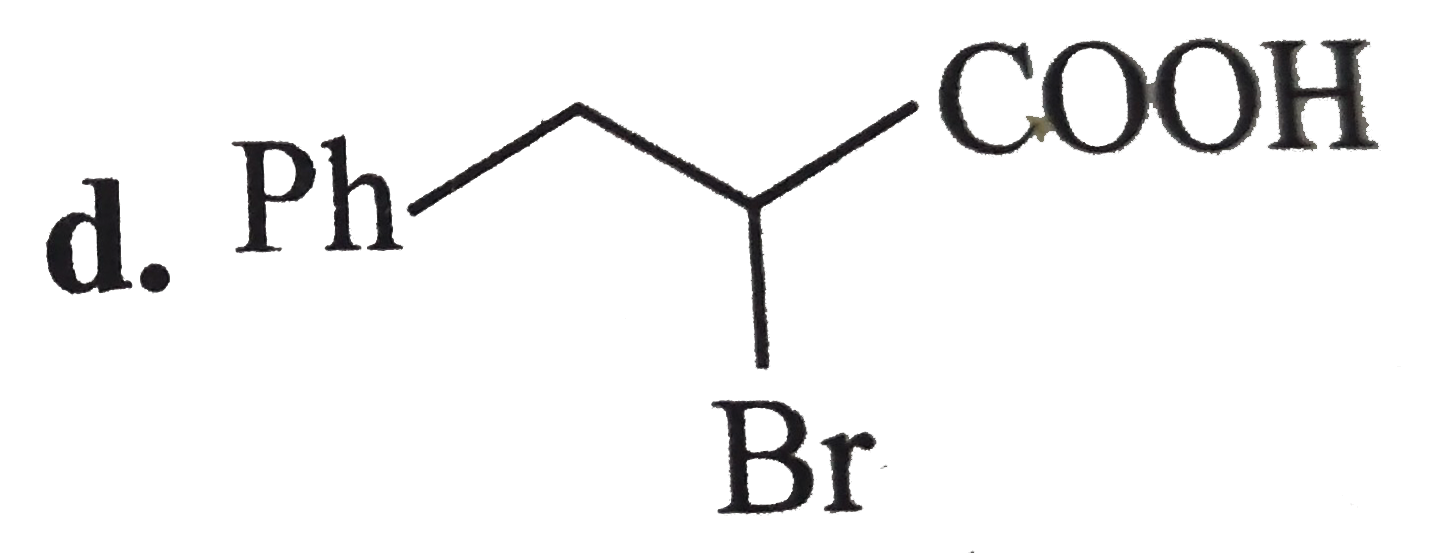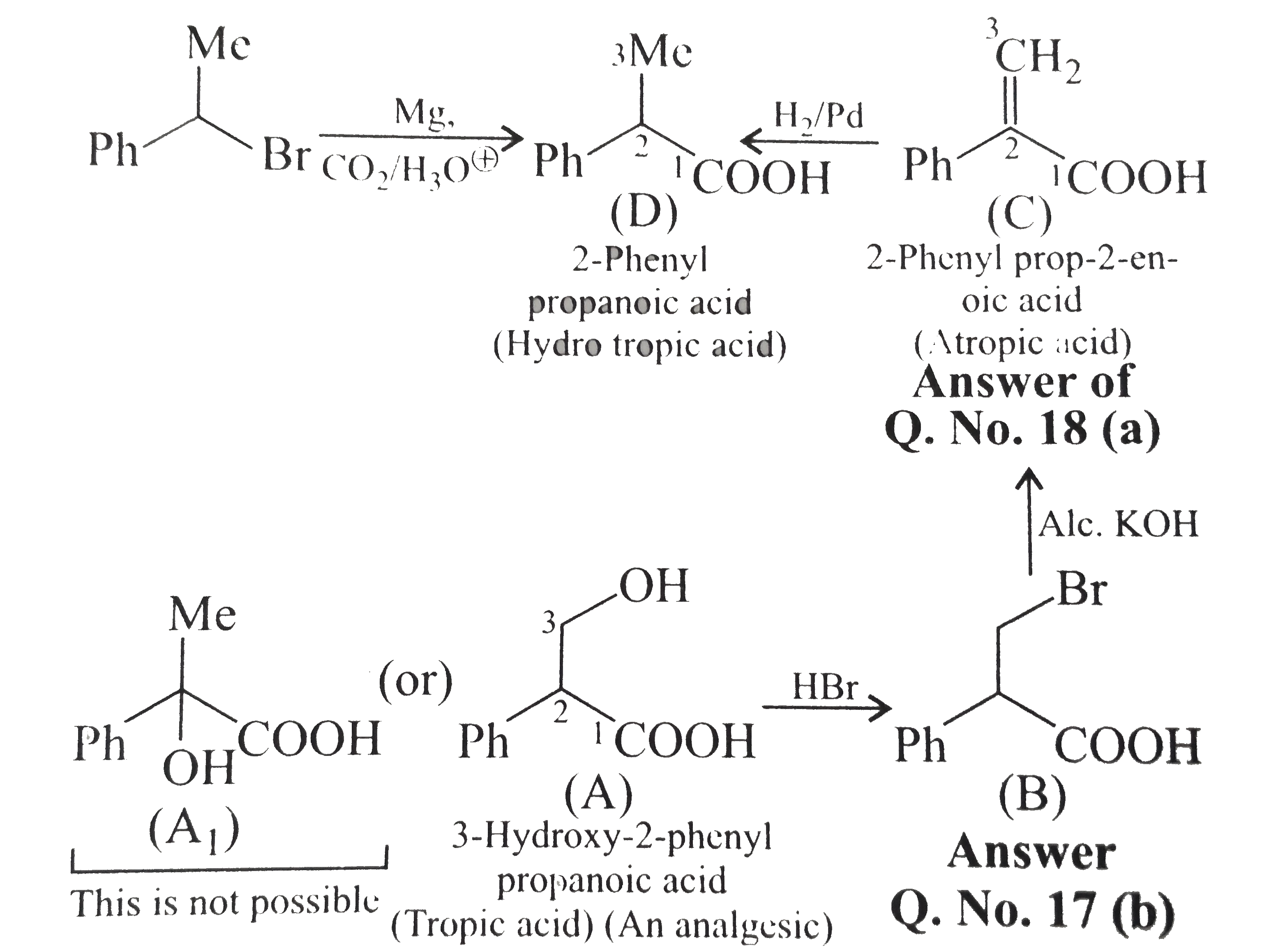Identify (D) in the reaction

(ii) Compound (D) is prepard by carbonation(Mg/ether,CO2/H3O+) of compound 


Both (a) and (b)

The correct Answer is:B
(b) Proceed reverse
Structure of (D) is :
 .
.
Topper's Solved these Questions
- CARBOXYLIC ACIDS AND THEIR DERIVATIVESBOOK - CENGAGE CHEMISTRY ENGLISHCHAPTER - CARBOXYLIC ACIDS AND THEIR DERIVATIVESEXERCISE - Exercises (Multiple Correct)
34 Videos
- CARBOXYLIC ACIDS AND THEIR DERIVATIVESBOOK - CENGAGE CHEMISTRY ENGLISHCHAPTER - CARBOXYLIC ACIDS AND THEIR DERIVATIVESEXERCISE - Exercises (Singlecorrect)
64 Videos
- CARBOXYLIC ACIDS AND THEIR DERIVATIVESBOOK - CENGAGE CHEMISTRY ENGLISHCHAPTER - CARBOXYLIC ACIDS AND THEIR DERIVATIVESEXERCISE - Exercises (Subjective)
19 Videos
- BIOMOLECULESBOOK - CENGAGE CHEMISTRY ENGLISHCHAPTER - BIOMOLECULESEXERCISE - Exercises Archives (Analytical And Descriptive)
8 Videos
- CHEMICAL KINETICSBOOK - CENGAGE CHEMISTRY ENGLISHCHAPTER - CHEMICAL KINETICSEXERCISE - Archives Subjective
23 Videos
Similar Questions
Knowledge Check
Identify the compounds (X), (Y) and (Z) in the following reaction :
CH3BrMg/ether−−−−−→X(i)CO2−−−−−→(ii)waterYCH3OH,H+−−−−−−−→ΔZA(X)=CH3MgBr,(Y)=CH3COOH,(Z)=CH3COOCH3B(X)=CH3CH2Br,(Y)=CH3CH2OH,(Z)=CH3CH2CH2CH3C(X)=CH3CH2MgBr,(Y)=CH3CH2COOH,(Z)=CH3CH2COCH3D(X)=CH3COOH,(Y)=CH3CH2COCH3,(Z)=CH3COOCH3
A hydrocarbon (A) containing 90% carbon and having V.D. 20 reacts with dil. H2SO4 in the presence of H2SO4 to give (B). Compound (B) is reduced by LiAIH4 to (C) which on heating with H2SO4 gives (D). Compound (A) can be converted into (D) directly by hydrogenation in the presence of deactivated palladium-calcium carbonate catalyst. Identity the compounds (A) to (D) and explain the reactions involved.
View SolutionIdentify the compounds A, B, C, D, E and F.

View SolutionIdentify compound (A) in the following reactions.
a.Compound (A)O3/H2+Pt→2−Methyl butanal and pentan −2−one
b. Identify (A) and (b).

View SolutionAn organic compound (A),C8H4O3 in dry benzene in the presene of anhydorus AlCl3 gives compound (B). Compound (B) on treatment with PCl5 followed by reaction with H2/Pd(BaSO4) gives compound (C) which on reaction with hydrazine gives a cyclised compound (D),(C14H10N2) Idenyify (A),(B),(C) and (D). Explain the formation of (D) from (C).
View SolutionThe compound C8H9Cl(A) on treatments with KCN followed by hydrolysis gives C9H10O2(B).Ammonium salt of B on dry distillation yields C.Which reacts with alkaline solution of bromine to gives C8H11N.(D),Another compound E (C6H10O) is obtained by the action of nitrous acid on D. or by the action of aquouspotash on A,E on oxidation gives F(C8H10O) Which gives the inner anhydride G on heating. The compound D is reaction with CHCl3+NaOH gives a compound H.
The compound A on reaction with AgCN gives :
View SolutionIdentify the compounds A, B, C, D, E and F:∗∗

View SolutionThe compound C8H9Cl(A) on treatments with KCN followed by hydrolysis gives C9H10O2(B).Ammonium salt of B on dry distillation yields C.Which reacts with alkaline solution of bromine to gives C8H11N.(D),Another compound E (C6H10O) is obtained by the action of nitrous acid on D. or by the action of aquouspotash on A,E on oxidation gives F(C8H10O) Which gives the inner anhydride G on heating.
The compound D is reaction with CHCl3+NaOH gives a compound H.The structure of H.
View Solution

